The Volkswagen Transporter range has been revised for 2021, with the new T6.1 line-up - as VW calls it - retaining an array of options for business buyers.
There’s the traditional vans in both short and long wheelbase, as well as a Crew Van option, and cab-chassis ute versions.
As has long been the case, VW Australia has gone with a relatively complex line-up of models, but also with a huge array of personalisation options for customers to tailor their vehicle to their specific requirements.
As well as that, the new model offers enhanced safety, technology, and a revised look. Is it enough to keep the mid-size VW van in the mix against the impressive Toyota HiAce, Ford Transit Custom and Peugeot Partner? Let’s find out.
Volkswagen Transporter 2021: Tdi250 Swb
| Engine Type | Diesel Turbo 4, 2.0L |
|---|---|
| Fuel Type | Diesel |
| Fuel Efficiency | 6.9L/100km (combined) |
| Seating | 3 |
| Price From | $22,220 - $27,500 |
Does it represent good value for the price? What features does it come with?
7 / 10
This is going to be complicated.
There are so many ways to build your VW Transporter T6.1 that you almost need a maths degree to ascertain the number of possible combinations and permutations.
Suffice to say, though, that the range starts under forty grand for a basic, low-powered manual front-wheel drive (FWD) short wheelbase (SWB), through to a high grade 4Motion all-wheel drive (4WD) long wheelbase (LWB) with a dual-clutch (DSG) automatic transmission.
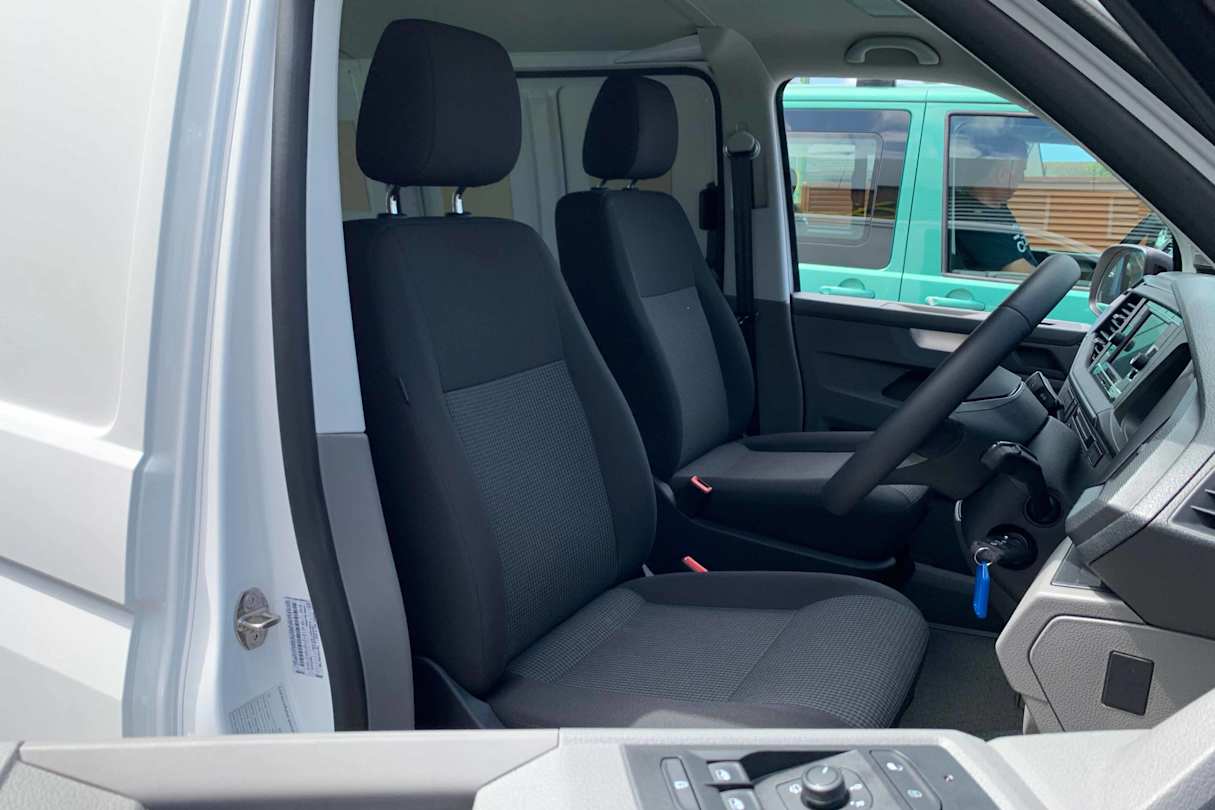
VW TRANSPORTER T6.1 VAN RANGE | |||
Body type | Engine | Drivetrain | Price (MSRP) |
SWB Van | TDI250 | 5-sp manual FWD | $38,990 |
| TDI340 | 6-sp manual FWD | $41,990 | |
7-sp DSG FWD | $44,990 | ||
7-sp DSG AWD | $47,990 | ||
| TDI450 | 7-sp DSG FWD | $50,990 | |
7-sp DSG AWD | $53,990 | ||
LWB Van | TDI340 | 6-sp manual FWD | $44,990 |
7-sp DSG FWD | $47,990 | ||
7-sp DSG AWD | $50,990 | ||
| TDI450 | 7-sp DSG FWD | $53,990 | |
7-sp DSG AWD | $56,990 | ||
There’s also the Transporter Crew Van range, with those versions getting a five-seat layout with a removable second-row bench. The bench has dual ISOFIX points built into the outboard positions, and there are top-tether restraints in the rear roof.
VW TRANSPORTER T6.1 CREW VAN RANGE | |||
Body type | Engine | Drivetrain | Price (MSRP) |
| SWB Crewvan | TDI340 | 7-sp DSG FWD | $51,490 |
7-sp DSG AWD | $54,490 | ||
| LWB Crewvan | TDI340 | 7-sp DSG FWD | $54,490 |
7-sp DSG AWD | $57,490 | ||
You may have noted that the entry-level and higher-spec powertrains aren’t available in the Crew Van, but they are the go-to options for the cab-chassis versions of the Transporter.
Below is a price list of the Transporter Single Cab and Transporter Dual Cab models, all of which come with a factory fit tray.
VW TRANSPORTER T6.1 CAB CHASSIS RANGE | |||
Body type | Engine | Drivetrain | Price (MSRP) |
| LWB Single Cab | TDI450 | 7-sp DSG FWD | $55,490 |
7-sp DSG AWD | $58,490 | ||
| LWB Double Cab | TDI450 | 7-sp DSG FWD | $57,490 |
7-sp DSG AWD | $60,490 | ||
Okay, so what about standard equipment for the Transporter range? All grades have standard halogen headlights and daytime running lights, and 16- or 17-inch steel wheels (with optional alloys for the TD340 and TDI450), cloth interior trim, LED interior lighting for cabin and cargo area, rubber floors in the cabin, a multimedia system with a 6.5-inch screen with Apple CarPlay and Android Auto, two USB-C ports and Bluetooth connectivity. You can option navigation for $1600, but there’s a standard auto-dimming rearview mirror, auto headlights, and auto wipers.
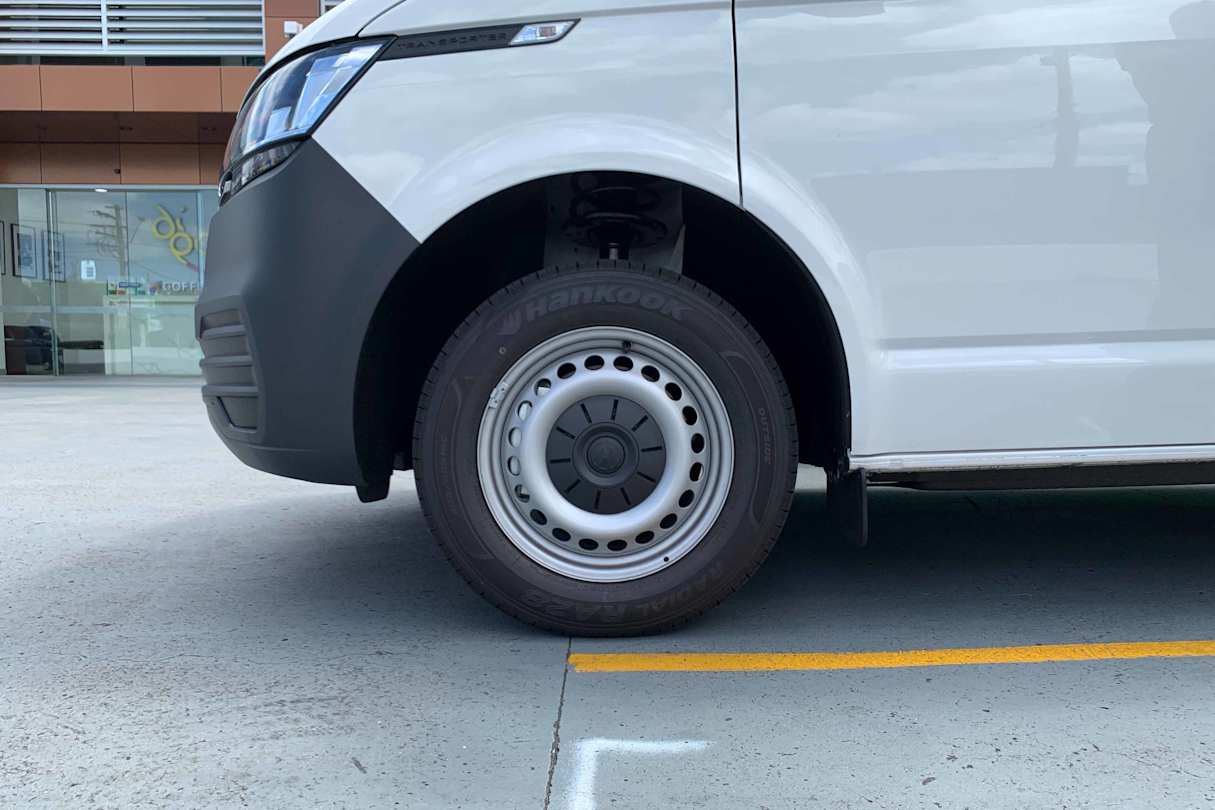

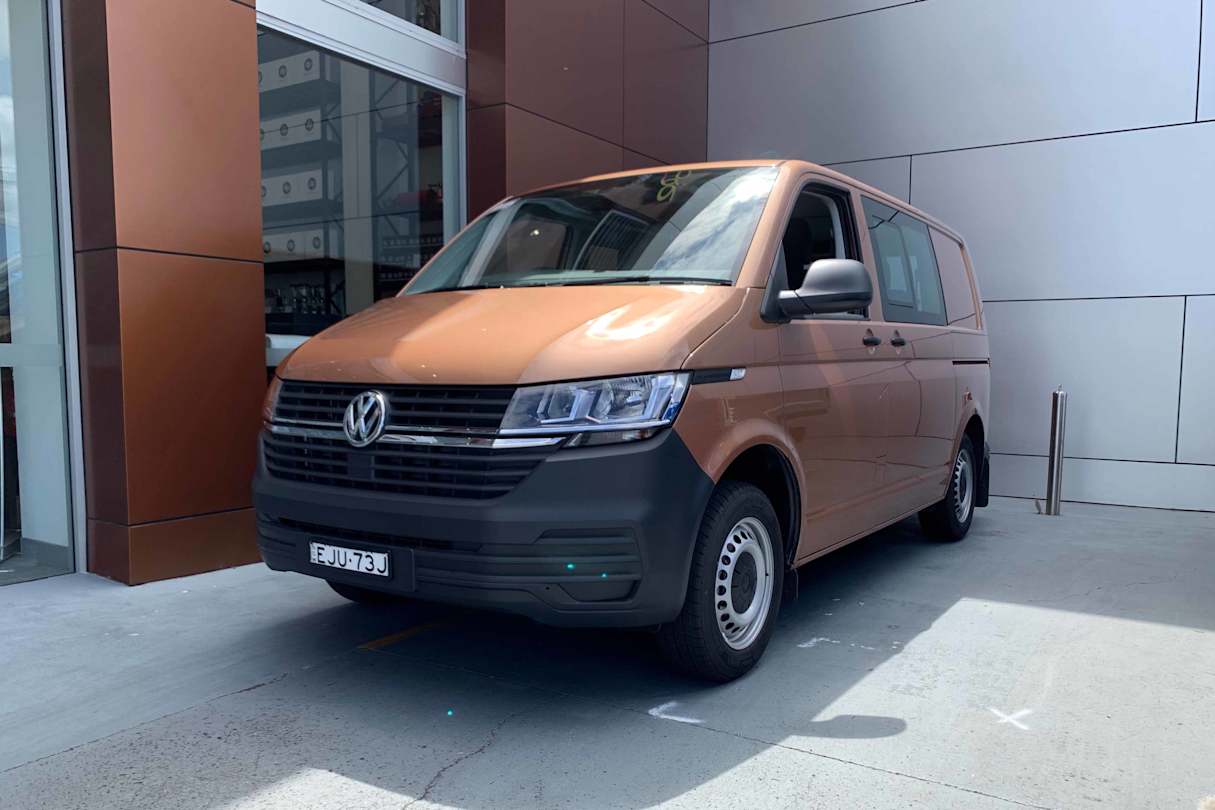
Note, for full colour coding it will cost you an additional $1130 (bumpers, mirrors, handles, grille) for vans, and a little less for the cab chassis models to have colour-matched bumpers ($800).
Is there anything interesting about its design?
8 / 10
There have been some subtle changes to this facelifted version of the Transporter. You mightn’t be able to tell them if you’re not looking closely, but that’s only going to help resale values of the existing model…
But the distinct little lines that run back from the headlights (like mascara, I’m told) that say “Transporter” in them are a nice touch, and it’s overall a really neat design. Always has been.
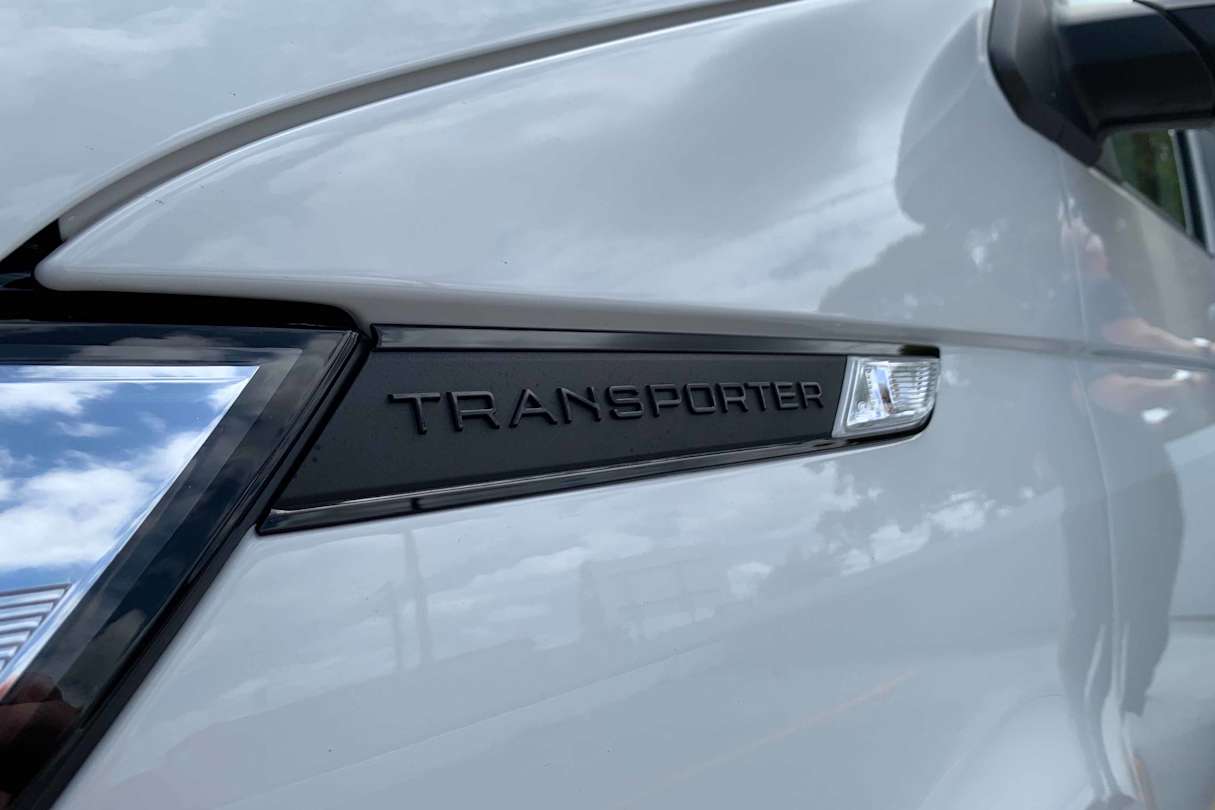
SWB Van | LWB Van | LWB High roof | Single Cab Chassis | Dual Cab Chassis | |
Length | 4904mm | 5304mm | 5304mm | 5500mm | 5500mm |
Wheelbase | 3000mm | 3400mm | 3400mm | 3400mm | 3400mm |
Width | 1904mm | 1904mm | 1904mm | 1994mm | 1994mm |
Height | 1990mm | 1990mm | 2477mm | 1948mm | 1948mm |
As you can see, there’s a lot of precision measurements there.
What about the cargo area, then? Here’s a rundown of those figures.
SWB Van | LWB Van | LWB High roof | Single Cab Chassis | Dual Cab Chassis | |
Cargo length | 2572mm (without partition) | 2975mm (without partition) | 2939mm | 2169mm | |
Cargo width | 1700mm | 1700mm | 1940mm | 1940mm | |
Width between arches | 1244mm | 1244mm | N/A | N/A | |
Cargo height | 1410mm | 1410mm | 1940mm | 392mm (tray depth) | 392mm (tray depth) |
Cargo volume | 5.8m3 | 6.7m3 | 9.3m3 | N/A | N/A |
The Crewvan versions have a second row in the back, so load length is lessened - there’s 1600mm in the SWB and 1967mm in the LWB. SWB models have six tie-down lashings, while LWB models get eight. The cargo volume for the normal roof SWB Crewvan is 3.5m3, and the LWB Crewvan offers 4.4m3 of cargo space.
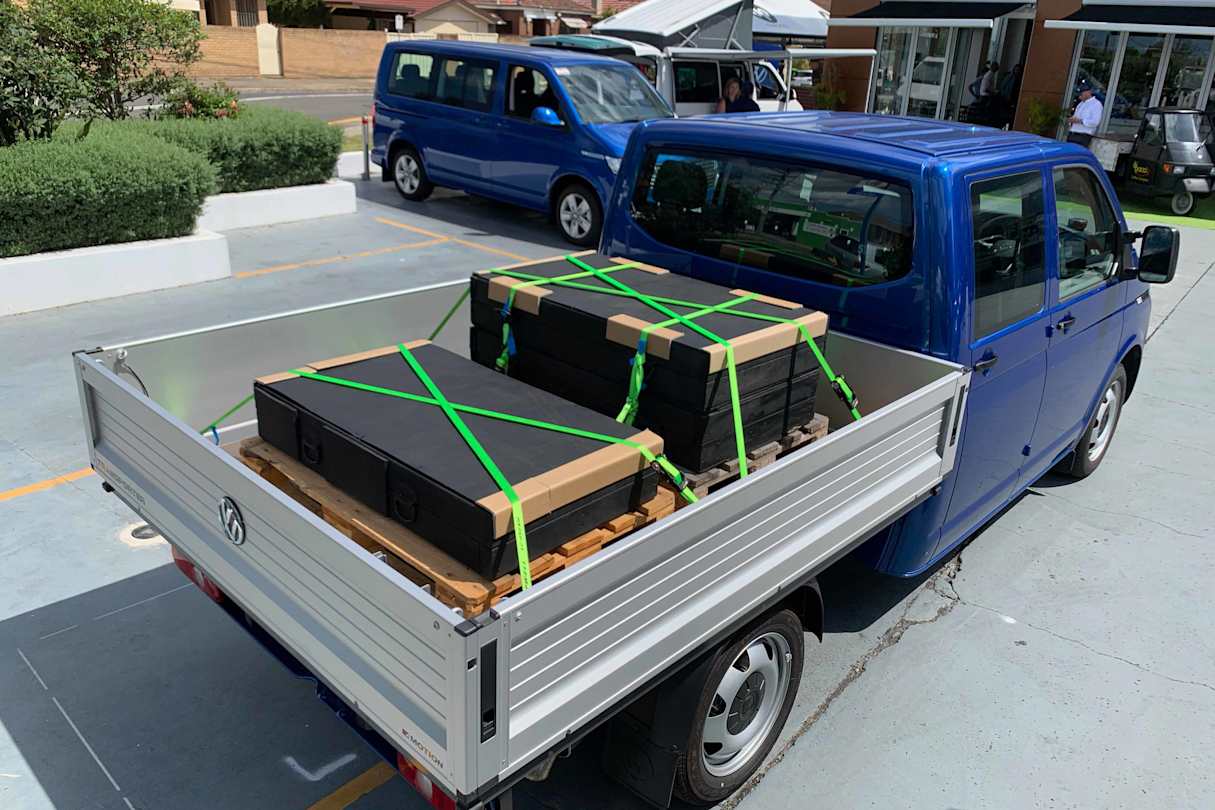
There are also optional off road suspension setups available with revised shocks and springs, and even stabilizer bar upgrades if needed. No changes to ride height or approach, departure and breakover angles, though.
What about payload capabilities? Here’s a rundown of load capacity for the vans and cab chassis models, including towing capacity.
Van (SWB, LWB, Crewvan) | Cab-chassis | |
Payload capacity | 951kg to 1220kg | 853kg to 1056kg |
Gross vehicle mass (GVM) | 2800kg (TDI250), 3000kg (all others) | |
Gross combination mass (GCM) | 5500kg (all variants) | |
Towing capacity | 750kg unbraked / 2500kg braked | |
Next, let’s take a look inside the revised cabin of the T6.1 Transporter.
How practical is the space inside?
9 / 10
The cabin of the VW Transporter has always been a thoughtful place, a suitable workspace for those who don’t just drive places, but also do paperwork in their ‘mobile office’.
That comes down to a clever level of storage, amenities and comfort.
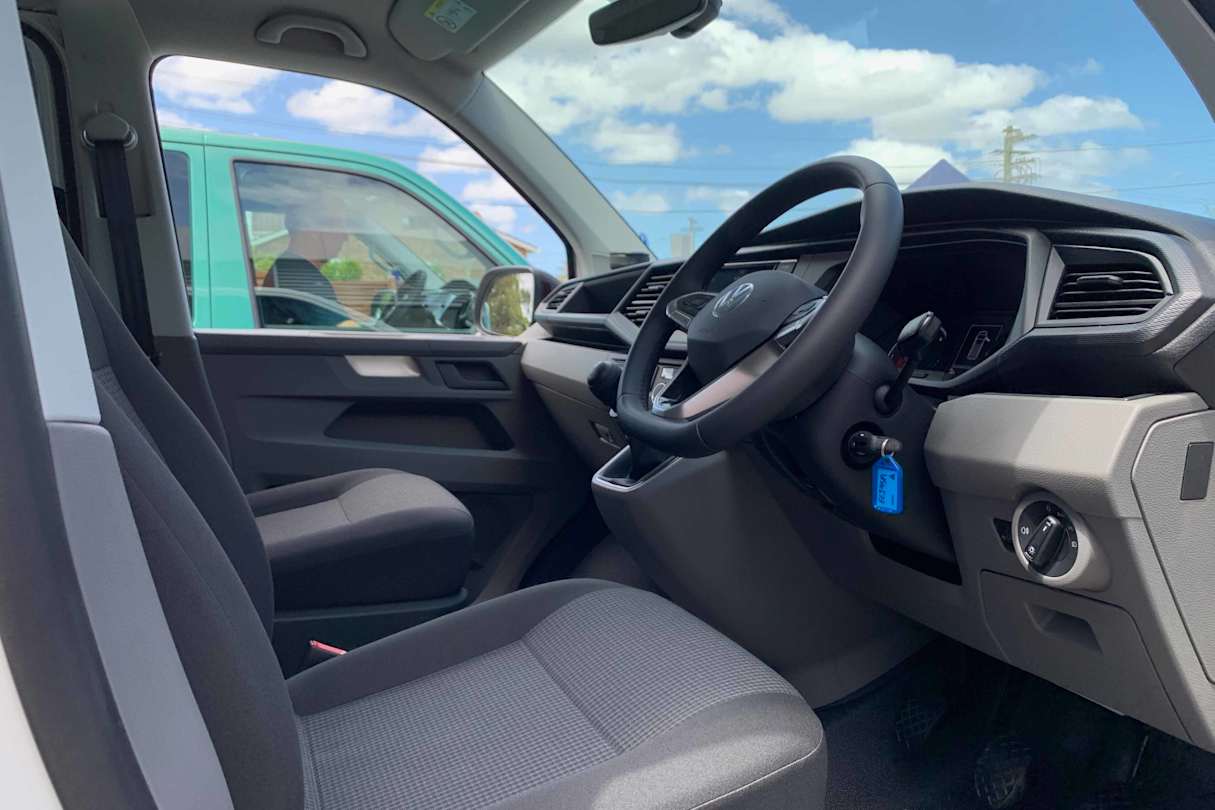
Let’s start with storage, as there are caddies and cubbies for loose items, documents and more. On the dash top there’s a folder holder, and there’s a shelf section above the glovebox. There are cup holders on top of the edges of the dash, too, and the door pockets have huge storage trenches with bottle holders.
Seat comfort is excellent, with good adjustment for the driver, and reach/rake adjustment for the leather-lined steering wheel, which is standard in all grades. The only thing missing is a grab handle to haul yourself into the seat if you’re shorter.
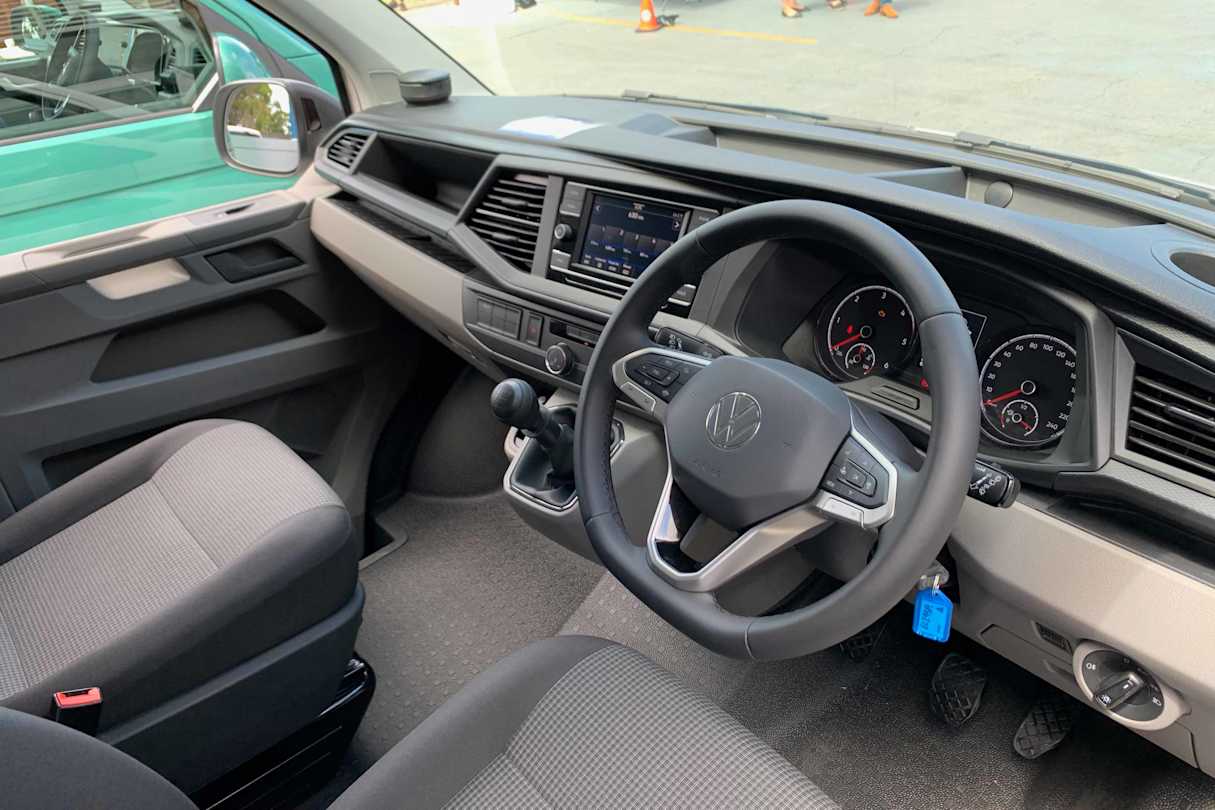
There’s a manual handbrake down on the floor to the left of the driver which is a reach for shorties, too (I wonder if the next-gen model might finally get an electric park brake?), and the new dashboard design has repositioned one of the driver’s air-vents a long way from them. The air-conditioning in one of the test vans was also a bit weak for a warm Aussie day.
But the dash design is attractive and certainly more modern than before, with more angular finishes and new media screens across the range. Though they aren’t that new compared to the brand’s non-commercial offerings, with the 6.5-inch touchscreen unit still offering Apple CarPlay and Android Auto and two USB-C ports (so you’ll need an adaptor or a new phone cable).
In the Crewvan the back seat space was comfortable but lacking a few features. At the very least, for tradie mums and dads there are dual ISOFIX child seat anchor points with two top-tether attachment hooks in the rear door area above the cargo hold. The back seat is removable if you only need it sometimes, too.
What are the key stats for the engine and transmission?
8 / 10
Plenty of options here.
You guessed it - it’s easier to show you in the below table.
TDI250 | TDI340 | TDI450 | |
Engine configuration | 2.0L turbo-diesel four-cylinder | 2.0-litre turbo-diesel four-cylinder | 2.0-litre twin-turbo diesel four-cylinder |
Power output | 81kW at 3500rpm | 110kW at 3250-3750rpm | 146kW at 4000rpm |
Torque output | 250Nm at 1250-3100rpm | 340Nm at 1500-3000rpm | 450Nm at 1400-2400rpm |
Transmission | 5-sp man | 6-sp man/7-sp DSG | 7-sp DSG |
Having three different outputs to choose from could be a compelling argument for some. If you know you’re okay with a low output manual, then why spend up to a more powerful unit?
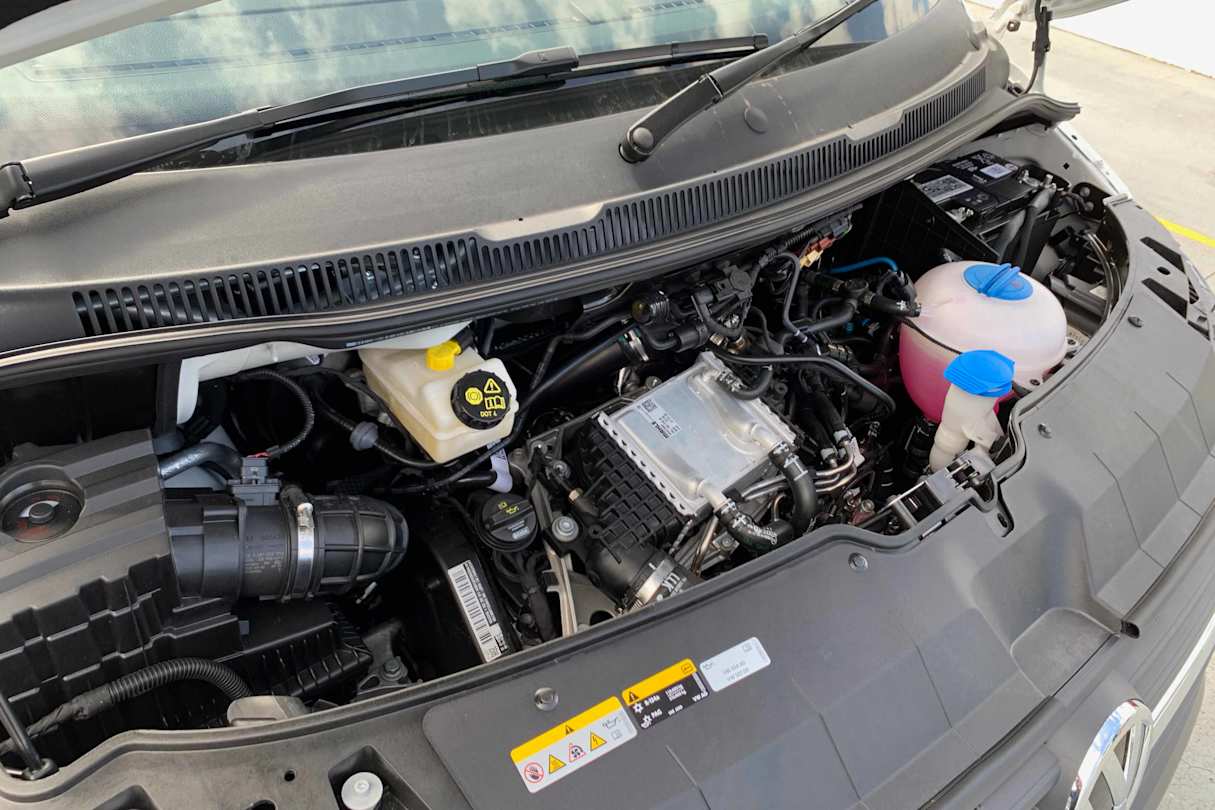
How much fuel does it consume?
8 / 10
The fuel consumption figures for the different models in the range vary depending on the application.
Again, rather than run though it all van by van, here’s a breakdown in a table.
TDI250 | TDI340 | TDI450 | |
Combined cycle fuel consumption - van models | 6.9L/100km (FWD man) | 7.5L/100km (FWD man) 8.3L/100km (FWD/AWD DSG) | 7.3L/100km (FWD DSG) |
Combined cycle fuel consumption - cab-chassis models (FWD) | 7.6L/100km (single cab FWD DSG) 7.5L/100km (dual cab FWD DSG) | ||
Combined cycle fuel consumption - cab-chassis models (AWD) | 8.4L/100km (single cab AWD DSG) 8.3L/100k m (dual cab AWD DSG) |
Fuel tank capacity for the base model TDI250 is 70L, while the rest of the range has 80L fuel tank size.
The TDI250 has engine start stop-technology, but doesn’t have AdBlue. The manual TDI340 and 4Motion TDI340 and TDI450 models doesn’t have either of those efficiency measures. The TDI340 DSG FWD is the only one with AdBlue and start-stop.
What's it like to drive?
9 / 10
The drive experience is very good.
At the launch event of the new T6.1 Transporter range, I drove a selection of different models some with weight and some without.
First was a TDI340 Crewvan with 260kgloaded in, and it was a really nicely sorted drive.
There was very good ride compliance and comfort. The suspension setup didn’t feel fussy or clunky, and it rode very well. The steering was excellent and very easy to judge, and it was easy to park thanks to its rear side glazing and good sized mirrors - though they aren’t dual pane like some rivals but there is blind-spot monitoring and rear cross-traffic alert, as well as a good reversing camera that made reversing into tight spots easier than it probably should be.

Warranty & Safety Rating
What safety equipment is fitted? What safety rating?
7 / 10
There have been advancements to the Transporter’s safety technology list, but the current generation model doesn’t have an ANCAP crash test safety score, and nor did the pre-facelift vehicle.
All models now come with low speed (up to 30km/h) autonomous emergency braking (AEB) designed for city driving, though it doesn’t have pedestrian or cyclist detection like some rivals. There is blind spot monitoring, rear cross-traffic alert and a reversing camera on van models with the tailgate fitted (barn doors and cab-chassis models miss out on the camera, blind spot and RCTA).
There’s a driver fatigue detection system, and van models score crosswind assist as part of the traction control and stability control system, while all models get the brand’s electronic differential lock to prevent slippage. There’s also multi-collision braking, which ensures you won’t careen into other vehicles after an impact.
Those who want it can option lane keep assist with lane departure warning, though similarly priced vans from rival makers don’t ask extra money for that.
There are dual front, front side and curtain airbags for all models. There is no second-row airbag coverage for Crewvan and dual-cab-chassis models.
If you’re looking for a van with more safety technology, be sure to take a squiz at the Toyota HiAce, Ford Transit Custom and Peugeot Expert.
What does it cost to own? What warranty is offered?
7 / 10
As with most van sellers in Australia, VW offers a competitive five-year/unlimited kilometre warranty.
There’s one year of roadside assist included for all new models sold. That can be refreshed if you service with VW, up to 10 years.
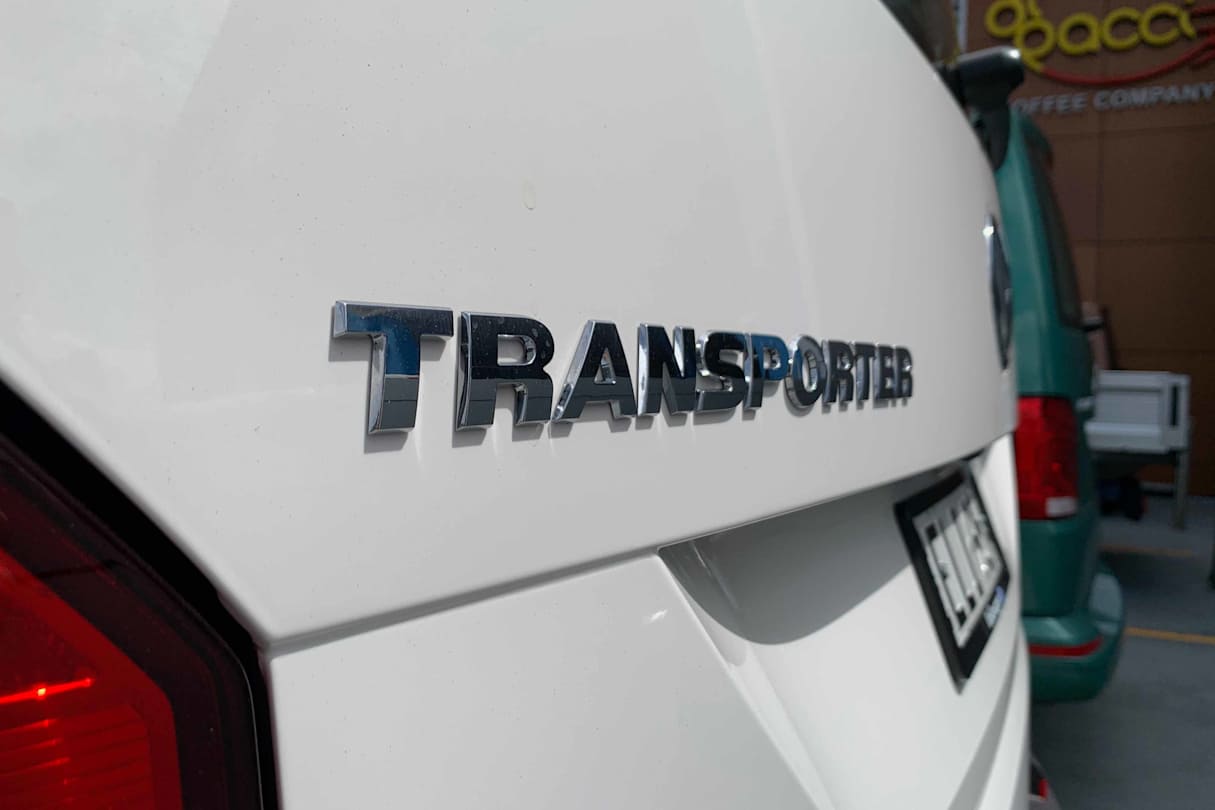
Verdict
There are more affordable vans out there to purchase and own. But not many offer the level of personalisation and quality, not to mention ease-of-use and drivability as the VW T6.1 Transporter range.
My pick would be a TDI340 DSG van in LWB, but there are several choices that would suit multiple different user cases.
Pricing Guides

Range and Specs
| Vehicle | Specs | Price* |
|---|---|---|
| Tdi250 Swb | 2.0L, Diesel, 5 SPEED MANUAL | $22,220 - $27,500 |
| Tdi340 Lwb | 2.0L, Diesel, 6 SPEED MANUAL | $25,630 - $31,680 |
| Tdi340 Swb | 2.0L, Diesel, 6 SPEED MANUAL | $23,980 - $29,590 |






.jpg)






















.jpg)
.jpg)
.jpg)
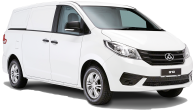

.jpg)



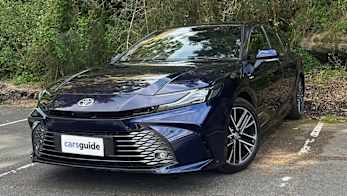
.jpg)